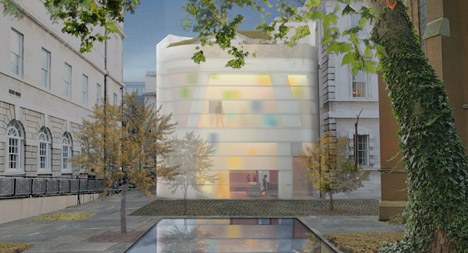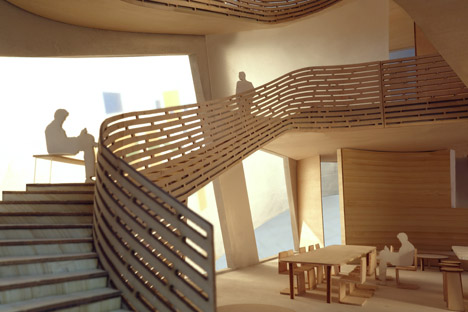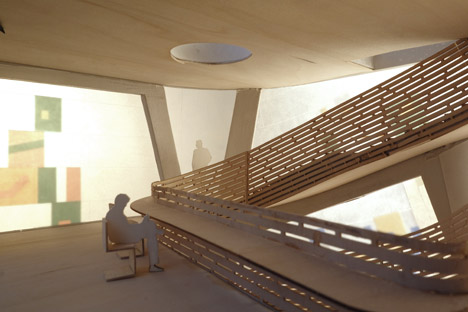Construction starts on Steven Holl-designed Maggie's Centre at London's oldest hospital
Construction has begun on Steven Holl's controversial Maggie's cancer-care centre at London's St Bartholomew's Hospital, which the architect says will respect rather than mimic its historic setting.
Maggie's Barts is being built next to the Grade I*-listed Great Hall, completed in 1738 by Scottish architect James Gibbs.
Conceived by the architect as a "vessel within a vessel within a vessel", the three-storey Maggie's Barts will feature a branching concrete framework with a bamboo lining and an interior of both matt-white and coloured glass.
The contemporary design has been a subject of contention since it was first revealed in 2012, but the project was granted planning permission in July and the building is now on target to open in late 2016, replacing a demolished 1960s structure.
"After making my first sketches years ago, I am extremely grateful for this special day," said Steven Holl at the ground-breaking ceremony yesterday.
The coloured glass fragments will be arranged in horizontal bands, intended to reference a musical staff.
Critics have argued that the building's contemporary appearance would have a detrimental effect on its setting within London's oldest hospital and tried unsuccessfully last year to replace Holl's scheme with another design by British architect Michael Hopkins.
In a movie about the project, Holl says his building will give a new life to the neighbouring James Gibbs structure, offering a "complementary contrast" to its grand stone facade and historic interiors.

"I believe to really respect the authenticity of historic architecture you must make an authentically new piece that doesn't overwhelm it, that complements it," he explains in the film.
"To really respect this James Gibbs building would not be to mimic it in some kind of a stone extension. You can't match the stonework, you can't match the quality or the craftsmanship, so that would be an unauthentic kind of action and I think that the authenticity of the James Gibbs piece deserves an authentic piece as a complementary contrast," says Holl.
The walls of the building will curve at the edges, framing the quoins of its 18th-century neighbour.

Coloured light will filter through from the facade, which Holl says will create a wash over the walls like a Mark Rothko painting.
A curving staircase will wind up through the interior, following the geometry of the glass facade. It will lead up to a roof garden dotted with trees, which will be used for meetings and activities such as yoga or Tai Chi.
"It's all in digitally perforated bamboo so there's a kind a warmth, like a basket-like quality of warmth and then there's stairs, very gentle stairs that bring you up. And then you see these colour washes come onto the floor and then you get the play of light and these musical notation analogies," says Holl.
"I think there's a kind of meditative quality, for me it would be a very nice place to spend time and to just relax. I think that's one of the main goals, to make the architecture really comforting and a place that you're inspired to spend time."

The Maggie's charity was founded by the late Maggie Keswick Jencks and her husband, architecture theorist Charles Jencks, and Maggie's Centres function as drop-in spaces to offer support to cancer sufferers, as well as their friends and relatives.
There are currently 18 centres in the UK, in buildings designed by architects including Snøhetta, OMA and Richard Rogers. Thomas Heatherwick has applied for planning permission to build a centre in Yorkshire.
Steven Holl – whose only other project in the UK is an extension to Charles Rennie Mackintosh's Glasgow School of Art – also plans to restore the landscaping around the church of St Bartholomew the Less with ginkgo trees and stone paving.